Last updated: February 8, 2022
Article
The Tomb of the Unknown Revolutionary War Soldier: Graffiti and the Legacy of the Founding Fathers
Transcript
I want to get us underway into this great discussion that's already going on in the chat.
So I'm going to invite Bill to kick us off.
Bill, can you tell us about Independence National Historical Park's response to the graffiti in terms both of a removal but also the way that you are interpreting the history of the monument and the history of George Washington?
[Bill Caughlan loads a presentation.]
BILL CAUGHLAN: All right. I'm going to be share-- trying to share my screen. Hi, everybody. Thanks for coming. Bear with me.
[His image now in the upper right hand corner. A Park Ranger hat as the wallpaper. In a video window, a statue of George Washington.]
[Text: Independence National Historic Park.]
[The Lives of Monuments: Tomb of the Unknown Revolutionary War Soldier, Thursday, June 17, 2021, 6:00 PM to 7:30 PM.]
BILL CAUGHLAN: OK. Can folks see the screen? OK.
[Inscription behind the statue of George Washington and the eternal flame: "Freedom is a light for which many men have died in darkness in unmarked graves."]
[Within this square lie thousands of unknown soldiers of Washington's Army who died of wounds and sickness during the Revolutionary War. "The independence and liberty you possess are the work of joint councils and joint efforts of common dangers sufferings and success." Washington's Farewell Address, 1796.]
[Images of ceremonies over the years.]
BILL CAUGHLAN: Yeah, for decades, everyone, the Tomb of the Unknown Revolutionary War soldier has often been a place of veneration, a place where local officials, veterans groups, visitors have come to pay their respects to those who sacrificed to bring about independence and the creation of the Republic that is the United States of America.
But that changed in the late spring of 2020 while Black Lives Matter protests were going on throughout the city.
At that point, the memorial was defaced.
On it was spray-painted the words, "committed genocide."
[The words "Committed GENOCIDE" spray painted on the monument. A barrier of metal fences, each with a sign.]
On a physical level, this act presented great challenges to the National Park Service staff in charge of the preservation of the resources at Independence National Historical Park.
But this act, also widely and sometimes vehemently condemned, caused the staff at Independence to look inward and to think again about how we interpret the resources and our care.
Resources that help to tell the story of the founding of the United States, which is a big part of this Park's mission.
[A map of Washington Square displays the location of several historical buildings.]
A little background.
The Tomb of the Unknown Revolutionary War Soldier is located within Washington Square. I don't know if this laser pointer thing works.
But it's a 6.5-acre plot of land located in the Southwest corner of Independence National Historical Park, cater-cornered from Independence Square. So here you can see Independence Hall, Washington Square's cater-corner. There you can see the tomb right in the middle of that spot.
[The cursor moves to a location on a faded paper map of Philadelphia.]
Washington Square itself is as old as the City of Philadelphia, originally called Southeast Square due to its location.
It was one of five open spaces that Pennsylvania founder William Penn wanted to include in his plans for a Green Country Town as he called it. For more than 100 years, it primarily served as pasture land and as a Potter's Field or burial ground for those Philadelphians considered undesirable i.e. the poor, suicide victims, executed criminals, Catholics, Native American Indians, and both free and enslaved Africans.
During the War for Independence, it served as a burial ground for soldiers, both American and British, who had perished as a result of the battles of Princeton, Trenton, Brandywine, and Germantown. And, again, during the British occupation of Philadelphia the winter of '77, '78.
[On another map of the area the cursor highlights Southeast Square next to 6th Street.]
The last bodies to be buried in Southeast Square were the victims of Philadelphia's yellow fever epidemic of 1794.
Burials ceased as it was reported, quote, "there were so many burials in Potter's Field that no more could be made without disturbing the remains of those previously interred." It's a lot of people. But I will say no one knows the exact number of burials in this square. It's in the thousands.
But soon after 1794, Southeast Square became a public park and promenade.
In 1816, it was proposed in Philadelphia City Council that all of the city squares be renamed in honor of prominent citizens.
[Another map features Washington Square near the center.]
It was at that time that Southeast Square became Washington Square, named for Philadelphia's temporary resident, George Washington, who, you may know, lived in this city while serving as the nation's first President.
[A fountain, flags at both sides of a walkway, and monument in a black and white. Illustration. Text: Study of Memorial to Unknown Soldiers in the Continental Army, Washington Square, Philadelphia.]
And now we fast forward to the 1950s. As a part of a redesign of Washington Square, a group of local businessmen decided to fund a memorial to the Unknown Revolutionary War Soldier.
It was also decided at that time to include a long planned monument to George Washington...
[Green trees behind the memorial and statue.]
...designed by architect G. Edwin Brumbaugh and dedicated in 1957. The memorial consists of a bronze replica of Jean-Antoine Houdon's standing figure of Washington placed on top of a granite pedestal.
Beneath that is a marble sarcophagus that holds the remains of an unknown Revolutionary War soldier exhumed from the Square.
The lid of the sarcophagus is inscribed with the words, "Beneath this stone rests the soldier of Washington's army, who died to give you liberty."
All of this is backed by a limestone wall with numerous inscriptions. The most prominent being, "Freedom is a light for which many men have died in darkness."
A propane-fueled eternal flame was dedicated in 1976 for the bicentennial.
And then another part of the memorial is two rows of flagpoles that flank the Bluestone Walk leading up to the monument itself. Each pole flies a battle flag. A flag from each of the original 13 states, as well as the first American flag.
[Scenes from various ceremonies.]
Throughout the years, the monument's been a place of commemoration. Wreath-laying ceremonies occur on Memorial Day, typically, Veterans Day, and Washington's birthday. That was from last year's commemoration. Though Washington's birthday is the only ceremony that actually honors George Washington, the rest-- For the most part, as the memorial suggests, the focus is mainly on the Unknown Soldier and the sacrifice that he and others made to help bring about a nation free and independent.
[The black and white illustration of the memorial.]
This memorial, like many in the 1950s, is very celebratory.
It was created at the height of the Cold War, when we as a nation were trying to illuminate the ideological contrast between American democracy and communism. And even now, with the Cold War being all but over, it still is a place that many come to contemplate the sacrifices made in the name of freedom.
[The image of the words "Committed GENOCIDE" on the Memorial.]
But as the graffiti suggests, not all agree that these freedoms in the United States are shared. Not everyone shares in the celebratory telling of this nation's founding. But we do not know exactly to whom the vandal is referring when they spray-painted "committed genocide," we can assume that it was directed at George Washington and not the Unknown Soldier.
Figuring out what group that Washington allegedly committed genocide against, it's a bit difficult to decipher. Though we can assume that it was either against Africans-- after all it was vandalized during Black Lives Matter unrest --- or Native Americans. Considering the fact that Washington oversaw the enslavement of over 570 Africans at his home at Mount Vernon from the time he took possession of the property until his death and that he refused to use his influence to bring about the end of slavery during his lifetime. As well as the fact that during his life, he participated in and sometimes spearheaded the removal of Native Americans from their tribal homelands as far back as the French and Indian War, all the way up through his Presidency.
It then might be easy for someone to come to the conclusion that Washington engaged in practices that led to the destruction of nations, cultures, and ethnicities. Even if this was not his intention, his actions have led some to accuse George Washington of engaging in genocide. With this in mind, and granted some of it is speculative, the staff at Independence had to face some questions and challenges in terms of upholding our mission of preservation.
[The graffiti.]
First, there's deciding what to do about the defacement of the memorial itself. Cultural resource management, they're the division that takes care of preserving the physical items within the park, had to document the vandalism. Then they needed to figure out how to remove the graffiti.
[Next to the graffiti on the ladder, a worker in a yellow vest.]
We had lots of offers from people to come and clean it off, but this required the work of professional conservators. The wall of the memorial is made a very soft, porous limestone. Some of the paint became embedded and needed special solvent that would sink into the stone.
[The paint, partially removed.]
It took many weeks, but the graffiti is virtually gone now.
[The memorial without the graffiti.]
While we understand the anger that some people felt about this act of vandalism, we also know that for some time, huge chunks of our nation's history has been left out of National Park Service interpretation. For the National Park Service interpretation is preservation.
Our job is to interpret these sites to inspire people to want to support the mission of preservation that the NPS is engaged in. In order to do this, we need the American public to know why these places, these memorials, and these stories they tell are important.
But if we don't tell the whole story, then we won't get the whole of the American people to support us.
That and it's the right thing to do.
We as a park and an agency have expanded many of the stories we tell to include people of different genders, sexual orientations, races, religions, and nationalities. But I know from personal experience, we have a lot more work to do.
We're not there yet, but I think we're headed in the right direction.
- Duration:
- 13 minutes, 46 seconds
Bill Caughlan, Park Ranger at Independence National Historical Park, relates the history of the Tomb of the Unknown Revolutionary War Soldier and describes the park’s response to the graffiti painted in June of 2021.
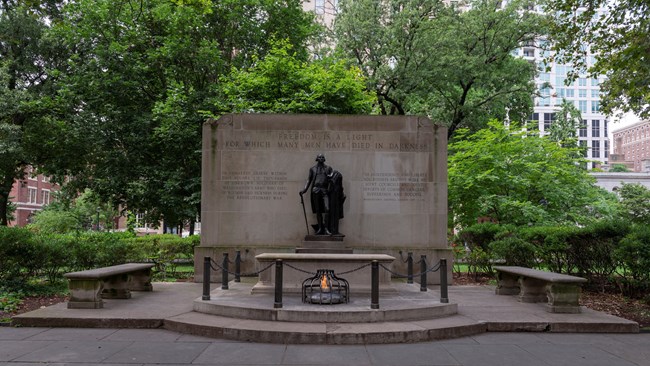
National Park Service
History of the Monument
Emma Silverman: I want to get us underway into this great discussion that's already going on in the chat.
So I'm going to invite Bill to kick us off.
Bill, can you tell us about Independence National Historical Park's response to the graffiti in terms both of a removal but also the way that you are interpreting the history of the monument and the history of George Washington?
Bill Caughlan: All right. I'm going to be share-- trying to share my screen. Hi, everybody. Thanks for coming. Bear with me.
OK. Can folks see the screen? OK.
Yeah, for decades, everyone, the Tomb of the Unknown Revolutionary War soldier has often been a place of veneration, a place where local officials, veterans groups, visitors have come to pay their respects to those who sacrificed to bring about independence and the creation of the Republic that is the United States of America.
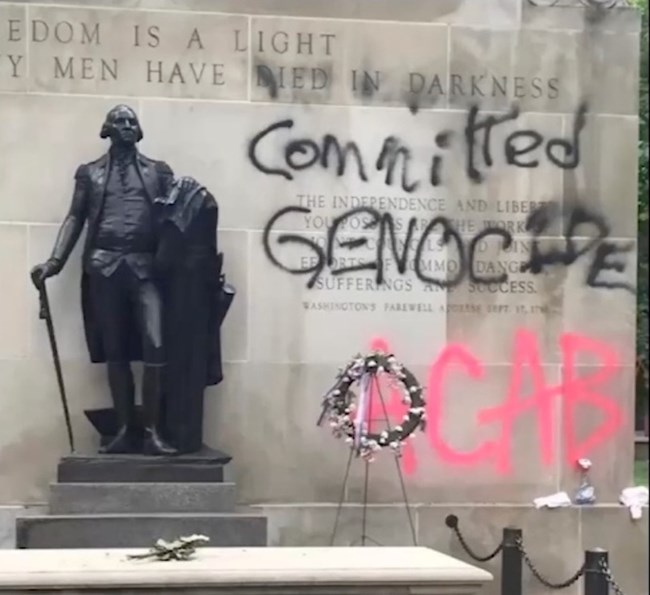
National Park Service
Graffiti
Bill Caughlan: But that changed in the late spring of 2020 while Black Lives Matter protests were going on throughout the city.
At that point, the memorial was defaced.
On it was spray-painted the words, "committed genocide."
On a physical level, this act presented great challenges to the National Park Service staff in charge of the preservation of the resources at Independence National Historical Park.
But this act, also widely and sometimes vehemently condemned, caused the staff at Independence to look inward and to think again about how we interpret the resources and our care.
Resources that help to tell the story of the founding of the United States, which is a big part of this Park's mission.
A little background.
Washington Square
The Tomb of the Unknown Revolutionary War Soldier is located within Washington Square. I don't know if this laser pointer thing works.
But it's a 6.5-acre plot of land located in the Southwest corner of Independence National Historical Park, cater-cornered from Independence Square. So here you can see Independence Hall, Washington Square's cater-corner. There you can see the tomb right in the middle of that spot.
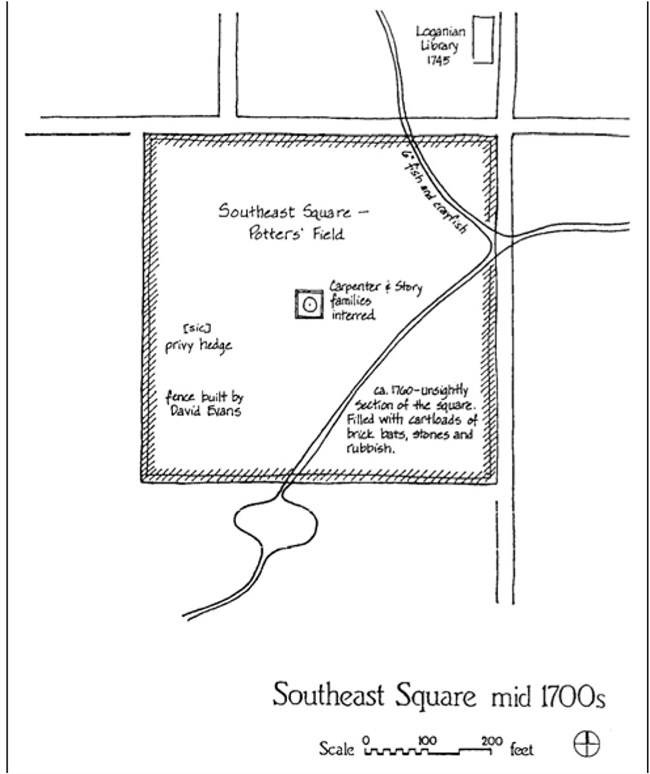
National Park Service
Washington Square itself is as old as the City of Philadelphia, originally called Southeast Square due to its location.
It was one of five open spaces that Pennsylvania founder William Penn wanted to include in his plans for a Green Country Town as he called it. For more than 100 years, it primarily served as pasture land and as a Potter's Field or burial ground for those Philadelphians considered undesirable i.e. the poor, suicide victims, executed criminals, Catholics, Native American Indians, and both free and enslaved Africans.
Burial Ground to Promenade
During the War for Independence, it served as a burial ground for soldiers, both American and British, who had perished as a result of the battles of Princeton, Trenton, Brandywine, and Germantown. And, again, during the British occupation of Philadelphia the winter of '77, '78.
The last bodies to be buried in Southeast Square were the victims of Philadelphia's yellow fever epidemic of 1794.
Burials ceased as it was reported, quote, "there were so many burials in Potter's Field that no more could be made without disturbing the remains of those previously interred." It's a lot of people. But I will say no one knows the exact number of burials in this square. It's in the thousands.
But soon after 1794, Southeast Square became a public park and promenade.
In 1816, it was proposed in Philadelphia City Council that all of the city squares be renamed in honor of prominent citizens.
It was at that time that Southeast Square became Washington Square, named for Philadelphia's temporary resident, George Washington, who, you may know, lived in this city while serving as the nation's first President.
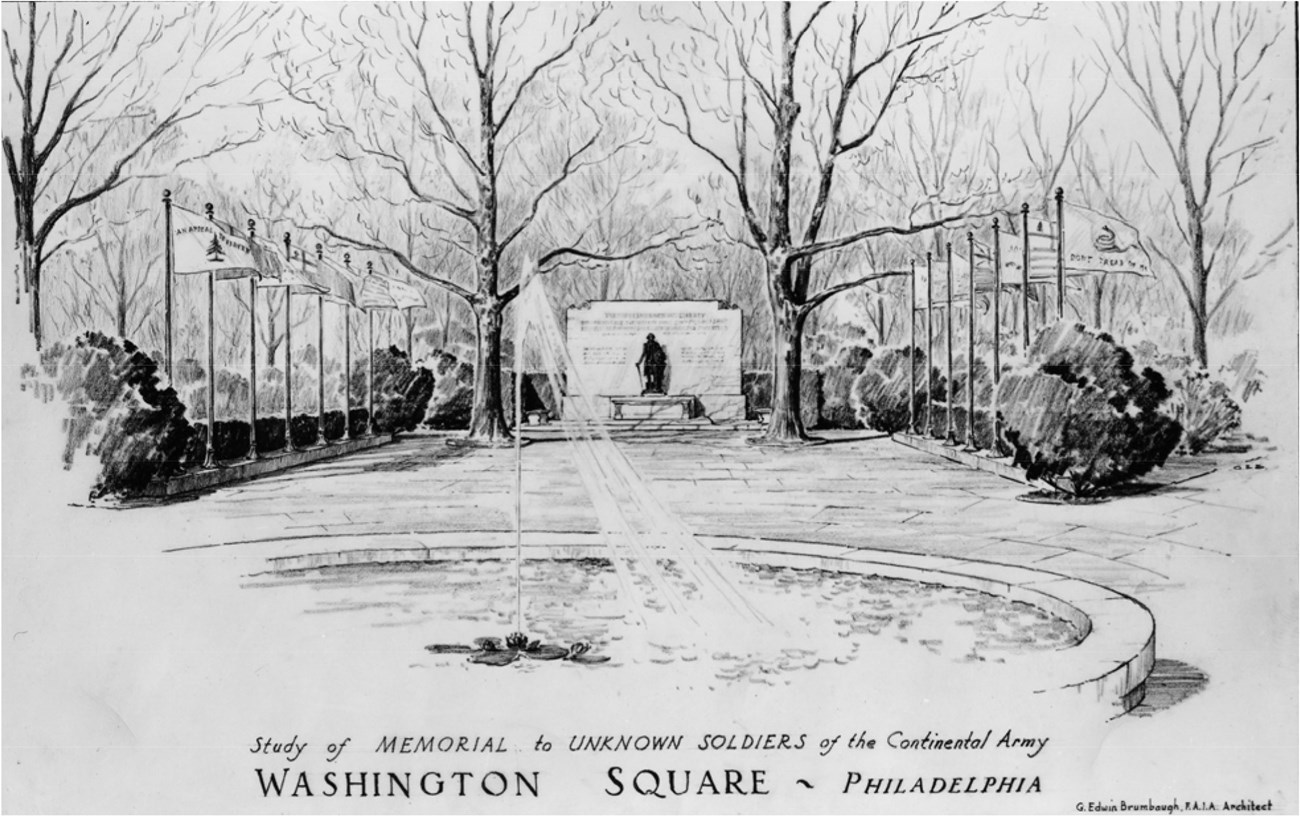
National Park Service
Development of the Memorial
And now we fast forward to the 1950s. As a part of a redesign of Washington Square, a group of local businessmen decided to fund a memorial to the Unknown Revolutionary War Soldier.
It was also decided at that time to include a long planned monument to George Washington designed by architect G. Edwin Brumbaugh and dedicated in 1957.
The memorial consists of a bronze replica of Jean-Antoine Houdon's standing figure of Washington placed on top of a granite pedestal.
![A marble sarcophagus that hold the remains of an unknown Revolutionary War Soldier. The lid of the sarcophagus is inscribed with the words, "Beneath this stone rests the soldier of Washington's army, who died to give you liberty." [Ranger Bill Caughlan, upper right hand corner.]](/articles/000/images/5-Tomb-Unknown-Soldier-American-Revolution-Sarcophagus.jpg?maxwidth=650&autorotate=false)
National Park Service
Beneath that is a marble sarcophagus that holds the remains of an unknown Revolutionary War soldier exhumed from the Square.
The lid of the sarcophagus is inscribed with the words, "Beneath this stone rests the soldier of Washington's army, who died to give you liberty."
All of this is backed by a limestone wall with numerous inscriptions. The most prominent being, "Freedom is a light for which many men have died in darkness."
A propane-fueled eternal flame was dedicated in 1976 for the bicentennial.
And then another part of the memorial is two rows of flagpoles that flank the Bluestone Walk leading up to the monument itself. Each pole flies a battle flag. A flag from each of the original 13 states, as well as the first American flag.
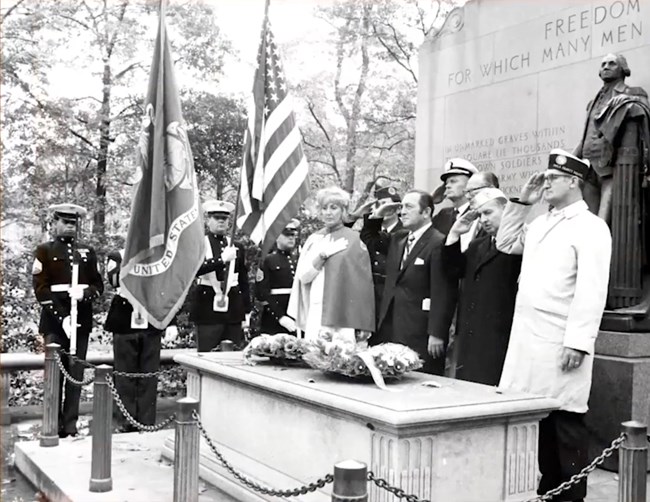
National Park Service
Commemoration
Throughout the years, the monument's been a place of commemoration.
Wreath-laying ceremonies occur on Memorial Day, typically, Veterans Day, and Washington's birthday. That was from last year's commemoration.
Though Washington's birthday is the only ceremony that actually honors George Washington, the rest-- For the most part, as the memorial suggests, the focus is mainly on the Unknown Soldier and the sacrifice that he and others made to help bring about a nation free and independent.
This memorial, like many in the 1950s, is very celebratory.
It was created at the height of the Cold War, when we as a nation were trying to illuminate the ideological contrast between American democracy and communism.
And even now, with the Cold War being all but over, it still is a place that many come to contemplate the sacrifices made in the name of freedom.
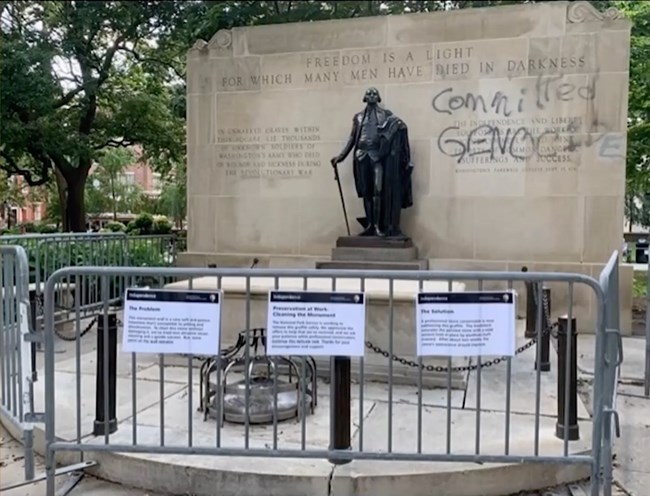
National Park Service
Graffiti & Interpretation
But as the graffiti suggests, not all agree that these freedoms in the United States are shared.
Not everyone shares in the celebratory telling of this nation's founding.
But we do not know exactly to whom the vandal is referring when they spray-painted "committed genocide," we can assume that it was directed at George Washington and not the Unknown Soldier.
Figuring out what group that Washington allegedly committed genocide against, it's a bit difficult to decipher.
Though we can assume that it was either against Africans-- after all it was vandalized during Black Lives Matter unrest --- or Native Americans. Considering the fact that Washington oversaw the enslavement of over 570 Africans at his home at Mount Vernon from the time he took possession of the property until his death and that he refused to use his influence to bring about the end of slavery during his lifetime.
As well as the fact that during his life, he participated in and sometimes spearheaded the removal of Native Americans from their tribal homelands as far back as the French and Indian War, all the way up through his Presidency. It then might be easy for someone to come to the conclusion that Washington engaged in practices that led to the destruction of nations, cultures, and ethnicities. Even if this was not his intention, his actions have led some to accuse George Washington of engaging in genocide.
With this in mind, and granted some of it is speculative, the staff at Independence had to face some questions and challenges in terms of upholding our mission of preservation.

National Park Service
Graffiti Removal
First, there's deciding what to do about the defacement of the memorial itself.
Cultural resource management, they're the division that takes care of preserving the physical items within the park, had to document the vandalism. Then they needed to figure out how to remove the graffiti.
We had lots of offers from people to come and clean it off, but this required the work of professional conservators.
The wall of the memorial is made a very soft, porous limestone. Some of the paint became embedded and needed special solvent that would sink into the stone. It took many weeks, but the graffiti is virtually gone now.
Re-Examining Interpretation
While we understand the anger that some people felt about this act of vandalism, we also know that for some time, huge chunks of our nation's history has been left out of National Park Service interpretation.
For the National Park Service interpretation is preservation.
Our job is to interpret these sites to inspire people to want to support the mission of preservation that the NPS is engaged in. In order to do this, we need the American public to know why these places, these memorials, and these stories they tell are important.
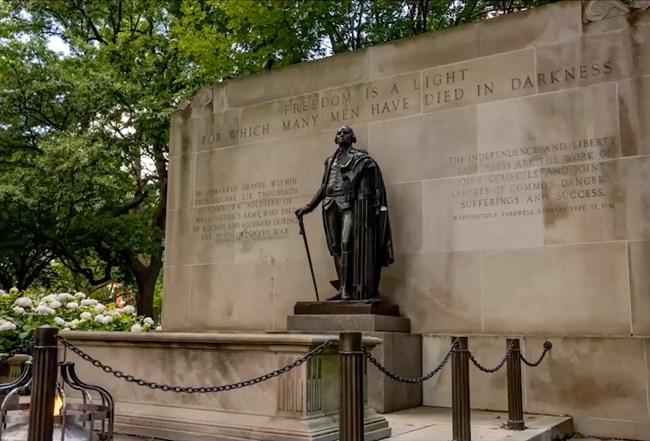
National Park Service
But if we don't tell the whole story, then we won't get the whole of the American people to support us.
That and it's the right thing to do.
We as a park and an agency have expanded many of the stories we tell to include people of different genders, sexual orientations, races, religions, and nationalities. But I know from personal experience, we have a lot more work to do.
We're not there yet, but I think we're headed in the right direction.
Transcript
So Rachel, one of the reasons that we're here tonight is that independence National Historical Park took the somewhat unusual step of actually photographing this graffiti and then posting it on social media.
Could you tell us about the National Park Service's existing policies around monuments and vandalism, and then explain the new proposals that encourage documentation of graffiti and other forms of vandalism and why this might be important.
[Rachel Adler appears in the inset on the screen featuring six examples of graffiti on stones and the back of a sign.]
RACHEL ADLER: Sure. Thank you so much. Thanks for inviting me to be a part of this really important conversation, sometimes a very difficult conversation.
So as Dr. Silverman mentioned, I'm going to change gears a little bit and talk not about this monument specifically, a bit about graffiti and the National Park Service. So what you're looking at here is a variety of graffiti from Western Parks which are mostly the parks that I work on. And I just wanted to underscore that graffiti is an issue that all National Park units deal with, it's not just urban parks, and it's not just during times of social unrest.
[She shows photos of the tomb from different angles. On one, black paint spells out "Y'all not tired yet?" On another black paint spells out "ACA BLM" and "END White silence." A third shows black and white paint some of which reads "ACAB" and {expletive "F"} 12. Finally, there is a photo of the Stuart County Standard newspaper with a headline reading, "Ignorance leads to desecration of mass grave marker."]
These are all examples of graffiti using various materials on different materials, different types of stone, and on different resources. So we have graffiti on natural resources on cultural resources, and on facilities on bathrooms and on the signs that you see when you go to National Parks. So these are all issues that are dealt with by national park staff, different divisions depending on what the graffiti effects. But it's a pervasive issue that's faced by that's faced across the country.
And because the graffiti on the tomb the Unknown Revolutionary War soldier was related to the protests of the summer of 2020. I'm going to talk a little bit about that. So, after the protests and during actually the protests in the summer of 2020, National Park Service staff was asked to give a virtual training on how to remove graffiti because so many parks and private entities were dealing with that issue and sometimes they were on structures of great cultural and historical importance, and depending on the structure and on the surface, graffiti removal can be actually really complicated.
So the focus of that training was actually removal techniques and materials and there was some documentation-- some discussion of documentation but it was primarily focused on documentation for crime scene investigation because of course graffiti is vandalism and vandalism is a crime. And also to collect evidence to either help find perpetrators of the vandalism or for use during prosecution.
Despite the fact that the training was in response to graffiti that was obviously connected with the protests and the social unrest. Aspects of removal and documentation weren't handled any differently than they would have been for any other type of vandalism. So a teenager tagging a monument with his name is not going to be handled any differently from graffiti that is obviously connected to social issues and issues of racial justice.
This led to discussions around whether we as Park Service employees had a responsibility beyond just being subject matter experts on materials conservation to address the larger societal issues that the graffiti was obviously representing. As National Park Service employees, we are charged with carrying out our individual or tasks individual tasks that are related to our specific fields of study, but we're also stewards of sites of historic importance that are meant to tell the stories of all Americans, and that includes Americans today who sometimes have a really complicated relationship with the places that the Park Service preserves.
[Text: {T}here is not a different policy for the removal of graffiti associated with the 2020 protests on NPS properties --- we are removing it as we would any graffiti or other similar form of vandalism. NPS's policy position does not preclude individual states or municipalities from making alternative treatment decisions should they choose to, and the question of whether so doing would impact NR or NHL eligibility of such resources would have to be considered through the normal evaluative process for changes/alterations to eligible or listed properties.]
And this is just again to confirm that the current policy for graffiti at the National Park Service sites applies to all graffiti regardless of context removal as soon as possible is what's recommended working under the assumption that's been studied and generally proven that graffiti begets more graffiti. So if people see that an area has already been vandalized, they are more likely to tag that area because the signal's sort of a value judgment of that surface of that area. If vandalized then other people don't value it, then it's OK for me to also vandalize it.
Graffiti removal does get complicated if the graffitied surface is historic and needs to be treated with care. As Bill mentioned, this memorial is limestone, which is relatively porous. It absorbs the graffiti material and makes it more difficult to remove. So graffiti often needs a unique approach for removal.
And often at park sites, things like sandblasting and power washing, which are generally used on public buildings and urban buildings where graffiti is a big issue, those aren't options on the kinds of resources that we deal with.
[A new screen shows a photo on the left featuring an inscription on stone and a photo on the right showing a water tower with painted graffiti reading in part "Home of the Free Indian." The caption below that photo reads "The newly rebuilt water tower with the restored graffiti Native Americans were invited to participate in tracing over the final block letters, Rameen Rahimian, The New York Times.]
Here you see on the left is a photo from the Pioneer Register and Capitol Reef National Park, which is in Utah, it's a canyon wall that holds the names of several early European settlers to the area.
And this is what if it happened today we would call it graffiti, but it's not, it is now preserved as a site of historic importance. The park website as well as signage along the trails to the site warns against vandalizing the area, including the graffiti in order to protect these existing inscriptions. And we call them inscriptions when they're important and we call it graffiti when it's unwanted.
On the right is an article from 2012 in the New York Times which talks about National Park Service led restoration of graffiti at Alcatraz that's associated with the Native American occupation of the island from 1969 to 1971. The effort to restore that graffiti did include Native American participants in its final stages, and I just I'm showing this slide to highlight the changing attitudes about graffiti and about how other-- the Park Service policy currently dictates that all graffiti be treated equally.
It's obvious that there are already differences that exist, and how it is treated depending on age, location and message. Of course, the difference is that these two photos show writing and graffiti that happened before these sites were National Park sites. And Alcatraz didn't believe-- didn't join the NPS until I believe the 1970s. So we have the benefit of time to decide that that graffiti was significant.
While graffiti appears at sites that are already National Park units, we're supposed to remove it without considering the potential significance that graffiti will have to future Americans and how it might speak to them about their past.
And I'm not suggesting and nobody in the Park Service is suggesting that graffiti be left untreated or that it be left on monuments that are important sites to a lot of people, but it is important that we think about how we might be able to preserve the information that graffiti contains about the culture and the environment in which it was created.
[Two pages from the NP Gallery digital asset management system. One features a photo of red paint graffiti on the Golden Gate NRA entrance that reads "Indians welcome in Indian Land." The second page shows the digital asset entry.]
And so finally with that in mind, a small group of Park Service employees have been meeting over the past year to develop a system of documentation that we are hoping will digitally preserve modern incidences of graffiti. So that future viewers, including scholars and historians can make the decision about whether or not graffiti is significant or instructive.
We are encouraging all NPS staff to record all graffiti not just graffiti that may be associated with current events to relieve them of the responsibility of making that judgment call. Any judgment that we make now any decision about what to preserve and what not to preserve is going to be influenced intentionally or unintentionally by our biases and our own personal histories as stewards and interpreters of these important places.
So we're using NP Gallery which is a publicly available and searchable digital asset database. We have a few required metadata fields, and several more recommended fields, but using the database isn't mandatory.
So it's suggested as sort of a favor to future historians and future scholars to provide them with information about the unrest and the graffiti that occurred in 2020 should they want that information in the future.
But because it's not mandatory, there are limitations in terms of staff and funding. And some parks, the sheer number of instances of graffiti that they deal with, it's not possible for them to record all of that information.
So I think this is a first step and just changing our views on how we handle this issue that's really pervasive and widespread but really, I think, deserves some critical thinking.
- Duration:
- 10 minutes, 21 seconds
Rachel Adler, an Architectural Conservator with the National Park Service, explains the agency’s existing policies pertaining to the vandalism of monuments as well as new proposals that encourage increased documentation.
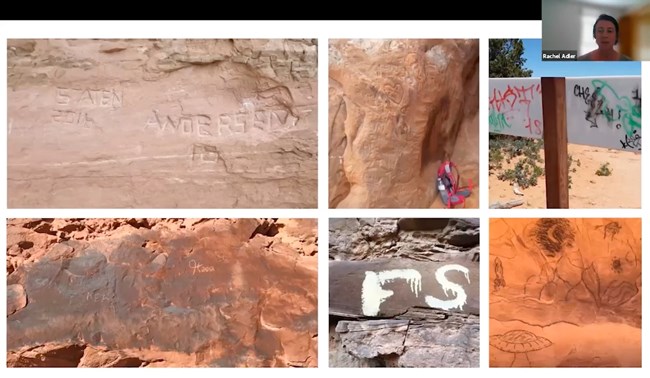
National Park Service
Graffiti Documentation
EMMA SILVERMAN: But for now, I wanted to turn to Rachel.
So Rachel, one of the reasons that we're here tonight is that independence National Historical Park took the somewhat unusual step of actually photographing this graffiti and then posting it on social media.
Could you tell us about the National Park Service's existing policies around monuments and vandalism, and then explain the new proposals that encourage documentation of graffiti and other forms of vandalism and why this might be important.
RACHEL ADLER: Sure. Thank you so much. Thanks for inviting me to be a part of this really important conversation, sometimes a very difficult conversation.
Graffiti and the National Park Service
So as Dr. Silverman mentioned, I'm going to change gears a little bit and talk not about this monument specifically, a bit about graffiti and the National Park Service. So what you're looking at here is a variety of graffiti from Western Parks which are mostly the parks that I work on.
And I just wanted to underscore that graffiti is an issue that all National Park units deal with, it's not just urban parks, and it's not just during times of social unrest.
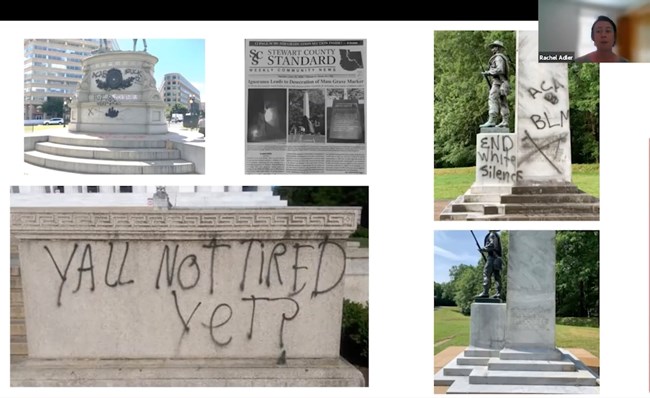
National Park Service
These are all examples of graffiti using various materials on different materials, different types of stone, and on different resources. So we have graffiti on natural resources on cultural resources, and on facilities on bathrooms and on the signs that you see when you go to National Parks.
So these are all issues that are dealt with by national park staff, different divisions depending on what the graffiti effects. But it's a pervasive issue that's faced by that's faced across the country.
And because the graffiti on the tomb the Unknown Revolutionary War soldier was related to the protests of the summer of 2020. I'm going to talk a little bit about that.
So, after the protests and during actually the protests in the summer of 2020, National Park Service staff was asked to give a virtual training on how to remove graffiti because so many parks and private entities were dealing with that issue and sometimes they were on structures of great cultural and historical importance, and depending on the structure and on the surface, graffiti removal can be actually really complicated.
Graffiti Removal and Documentation
So the focus of that training was actually removal techniques and materials and there was some documentation-- some discussion of documentation but it was primarily focused on documentation for crime scene investigation because of course graffiti is vandalism and vandalism is a crime. And also to collect evidence to either help find perpetrators of the vandalism or for use during prosecution.
Despite the fact that the training was in response to graffiti that was obviously connected with the protests and the social unrest. Aspects of removal and documentation weren't handled any differently than they would have been for any other type of vandalism. So a teenager tagging a monument with his name is not going to be handled any differently from graffiti that is obviously connected to social issues and issues of racial justice.
This led to discussions around whether we as Park Service employees had a responsibility beyond just being subject matter experts on materials conservation to address the larger societal issues that the graffiti was obviously representing. As National Park Service employees, we are charged with carrying out our individual or tasks individual tasks that are related to our specific fields of study, but we're also stewards of sites of historic importance that are meant to tell the stories of all Americans, and that includes Americans today who sometimes have a really complicated relationship with the places that the Park Service preserves.
And this is just again to confirm that the current policy for graffiti at the National Park Service sites applies to all graffiti regardless of context removal as soon as possible is what's recommended working under the assumption that's been studied and generally proven that graffiti begets more graffiti. So if people see that an area has already been vandalized, they are more likely to tag that area because the signal's sort of a value judgment of that surface of that area. If vandalized then other people don't value it, then it's OK for me to also vandalize it.
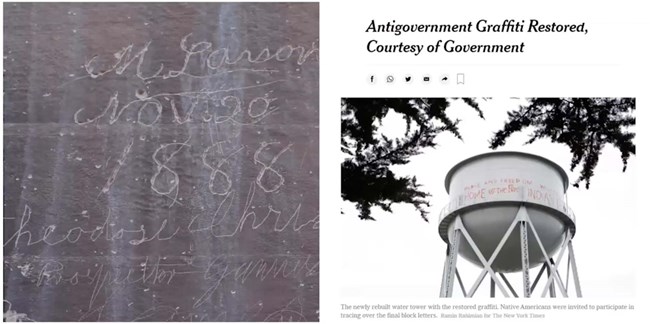
National Park Service
Graffiti removal does get complicated if the graffitied surface is historic and needs to be treated with care. As Bill mentioned, this memorial is limestone, which is relatively porous. It absorbs the graffiti material and makes it more difficult to remove. So graffiti often needs a unique approach for removal.
And often at park sites, things like sandblasting and power washing, which are generally used on public buildings and urban buildings where graffiti is a big issue, those aren't options on the kinds of resources that we deal with.
Here you see on the left is a photo from the Pioneer Register and Capitol Reef National Park, which is in Utah, it's a canyon wall that holds the names of several early European settlers to the area.
Inscriptions vs. Graffiti
And this is what if it happened today we would call it graffiti, but it's not, it is now preserved as a site of historic importance. The park website as well as signage along the trails to the site warns against vandalizing the area, including the graffiti in order to protect these existing inscriptions.
And we call them inscriptions when they're important and we call it graffiti when it's unwanted.
On the right is an article from 2012 in the New York Times which talks about National Park Service led restoration of graffiti at Alcatraz that's associated with the Native American occupation of the island from 1969 to 1971.
The effort to restore that graffiti did include Native American participants in its final stages, and I just I'm showing this slide to highlight the changing attitudes about graffiti and about how other-- the Park Service policy currently dictates that all graffiti be treated equally.
It's obvious that there are already differences that exist, and how it is treated depending on age, location and message. Of course, the difference is that these two photos show writing and graffiti that happened before these sites were National Park sites. And Alcatraz didn't believe-- didn't join the NPS until I believe the 1970s. So we have the benefit of time to decide that that graffiti was significant.
While graffiti appears at sites that are already National Park units, we're supposed to remove it without considering the potential significance that graffiti will have to future Americans and how it might speak to them about their past.
And I'm not suggesting and nobody in the Park Service is suggesting that graffiti be left untreated or that it be left on monuments that are important sites to a lot of people, but it is important that we think about how we might be able to preserve the information that graffiti contains about the culture and the environment in which it was created.
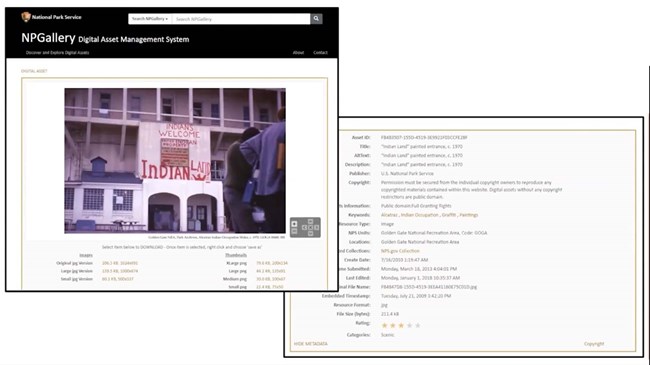
National Park Service
Documenting for Future Historians
And so finally with that in mind, a small group of Park Service employees have been meeting over the past year to develop a system of documentation that we are hoping will digitally preserve modern incidences of graffiti. So that future viewers, including scholars and historians can make the decision about whether or not graffiti is significant or instructive.
We are encouraging all NPS staff to record all graffiti not just graffiti that may be associated with current events to relieve them of the responsibility of making that judgment call.
Any judgment that we make now any decision about what to preserve and what not to preserve is going to be influenced intentionally or unintentionally by our biases and our own personal histories as stewards and interpreters of these important places.
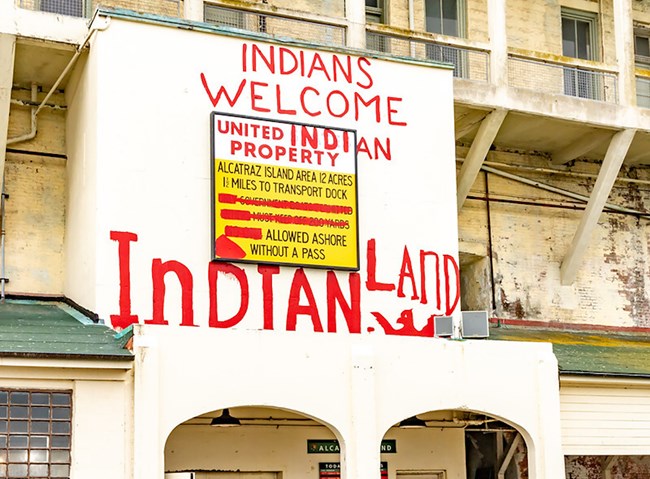
National Park Service
So we're using NP Gallery which is a publicly available and searchable digital asset database. We have a few required metadata fields, and several more recommended fields, but using the database isn't mandatory.
So it's suggested as sort of a favor to future historians and future scholars to provide them with information about the unrest and the graffiti that occurred in 2020 should they want that information in the future.
But because it's not mandatory, there are limitations in terms of staff and funding. And some parks, the sheer number of instances of graffiti that they deal with, it's not possible for them to record all of that information.
So I think this is a first step and just changing our views on how we handle this issue that's really pervasive and widespread but really, I think, deserves some critical thinking.
Transcript
Erika, can you talk about why different publics vandalize cultural property especially when that vandalism is done to make a political statement, as it was at the Tomb of the Unknown Revolutionary War soldier?
ERIKA DOSS: I can, and here we go. Let me see if I can get my PowerPoint set up here.
[Shares screen. Presentation: Monuments Memory and Cultural Vandalism, National Park Service series: The Lives of Monuments.]
How does that look? OK. Thanks, Emma, for inviting me to participate in today's conversation about monuments, memory, and vandalism.
And I do sort of hope to hop on to what Bill and Rachel are talking about regarding this particular incident of vandalism. My remarks are going to focus on, as Emma suggested, how and why some American publics are motivated to deface cultural property and what these acts of cultural vandalism tell us about the meaning of monuments and memory in contemporary America.
[Slide.]
So last summer, following George Floyd's murder in Minneapolis by police on May 25, widespread protests throughout the United States and around the world against systemic or structural racism and police violence occurred.
And I just show a few examples here of the kind of images that we saw and experienced.
[Slide.]
Some protesters in Philadelphia, tens of thousands, rallied at the Philadelphia Art Museum or outside. Some protesters targeted public monuments, such as these managed by the National Park Service. And Rachel showed a few of these images as well in Boston and in Washington, D.C., so the Lincoln Memorial, the World War II Memorial, and on the left the backside of the Shaw Memorial in Boston.
[Slide. Images.]
Others targeted figurative sculpture in the United States, particularly of US presidents deemed representatives of white supremacy and racial inequity, such as Andrew Jackson --- this is the statue of him in Kansas City --- and George Washington. This is a statue that was toppled. So we're looking at it lying on the ground here. And yellow paint was thrown on it. And, also, you'll see on the far left of the pedestal the words "genocidal maniac."
[Slide. Images.]
In Philadelphia, long-time protest against this larger-than-life-sized statue of Frank Rizzo, which was in front of the city's municipal building, and those protests included --- I have on the left being yarn bombed in 2012 and dressed in a pink bikini.
Long-time protests finally led to the statue's removal by order of Mayor Jim Kenney. So this was part of the May and June protest. And likewise, this statue of Christopher Columbus in Marconi Plaza, which had similarly been the subject of sustained and really heated public protests in South Philadelphia, this was boarded up as we see on the bottom and eventually removed from the site.
[Slide.]
And as we've seen in Washington Square here in Philadelphia, graffiti was spray-painted at the Tomb of the Unknown Revolutionary War soldier. So to the right of the Statue of George Washington --- and as Bill said, this is a copy of the statue designed by French artist Houdon --- under the sentence, "Freedom is a light for which many men have died in darkness," chiseled into this limestone wall, somebody wrote the words "committed genocide," and then underneath that as well, someone tagged ACAB short for "All Cops Are Bastards" in bright pink paint.
Graffiti takes many forms.
[Slide. Images: Banksy, "I Remember When (2010)."]
Today, the work of the very well-known British artist Banksy is called street art, not vandalism. And it commands very high prices in the art market and generally broad appreciation for this artist's particular attention to social and political issues.
But the vandalism of national monuments disturbs people.
[Slide. Chat.]
Hundreds of people responded to the NPS social media postings, which I include here, on these incidents in Washington and also in Philadelphia, the statement by the NPS on the left and just some of the many comments that we see on the right.
For many people, vandalism is property destruction and criminal behavior. And indeed, as Rachel pointed out, in US law, vandalism is typically considered a crime subject to penalties from fines and restitution to jail time.
[Slide. Chat.]
The word vandalism, the art historian Sabine Marschall recounts, carries negative connotations associated with violence, unlawfulness, disrespect, disobedience, uncivilized behavior. Defacing a War Memorial that features the figure of America's founding father was seen by many as a sign of civic disorder, and it was denounced as desecration and even iconoclasm.
[Slide.]
The cultural vandalism seen here, directed at monuments dedicated to Washington, Robert E. Lee, and Christopher Columbus, is an intentional defacement of cultural property.
It is also an expression of rage, pain, and mourning, a very public declaration that things are very wrong in America, that American citizens are being brutalized, that voices are not being heard, that histories are being denied. Defacing monuments that seem to promote systemic racism and violence or ignore, as this case suggests, George Washington's role in the destruction and devastation, his words, of Indigenous Americans to make way for a new nation of white male landowners may be seen as an act of civil disobedience, a demand for alternative, expanded understandings of early American history of how the US actually came into being.
[Slide. Image: Lincoln Memorial.]
Monuments are the physical markers of social, political, and economic interest. They are highly visible stakeholders in historical memory. And they possess enormous degrees of power and influence, shaping how we feel about ourselves, our neighbors, our nation. Their symbolic capital, following Pierre Bourdieu, helps shape and direct public perceptions of social order, political transition, and national identity.
[Slide.]
When monuments embody values that Americans deem aberrant or inappropriate, when they seem to possess negative symbolic capital, such as white supremacy, slavery, Indigenous dispossession, they may be defaced. They may be removed.
I call this process cultural vandalism --- damaging and/or removing public art for reasons related to changing or shifted understandings of social and political purpose and identity.
And I want to make a distinction here between cultural heritage vandalism and cultural vandalism, which I'd be happy to elaborate on during our roundtable.
[Slide. Painting.]
Americans have practiced cultural vandalism since the nation's beginnings. On July 9, 1776, for example, General George Washington organized a public reading of the Declaration of Independence in New York. Thomas Jefferson listed 27 grievances against King George in the Declaration
Summarized in this sentence, "a prince whose character is thus marked by every act which may define a tyrant is unfit to be the ruler of a free people."
Inspired by words encouraging them to dissolve the political bands of tyranny, to seek unalienable rights of life, liberty, and happiness, the crowd in New York pulled down this two-ton statue of the king, which had been modeled on a statue of Marcus Aurelius.
Note the participants gather together in Johannes Oertel's version of the scene --- women, children, merchants, working men, people of color, Native Americans.
[Slide. Painting.]
A few years later, William Walcutt also depicted the scene of America's transformation from colony to nation. His paintings similarly shows sacred power falling to the people and suggest how public rituals of cultural vandalism, here seen in the form of statue removal, helped legitimate claims to new forms of social and political authority.
[Slide. Image.]
So these practices of cultural vandalism continue today, similarly sparked by public disaffection with various forms of social and political authority, such as systemic racism and police brutality and their negative symbolic capital as embodied in some examples of public art.
[Slide.]
The graffiti at the monument in Philadelphia may have been motivated, as Bill suggested, by discontent with laudatory or one-dimensional images of George Washington and the lack of attention to what historian Colin Calloway describes as Washington's torturous relationship with Native Americans.
Cultural vandalism makes the negative symbolic capital of troubling memorials visible. It pushes us to recognize the more nuance to the more complicated faces and facts of history. Its practice today suggests the shared concerns of Americans who aim to reconcile historical accountability with national identity and, importantly, national futurity.
In this sense, markers of dissent like the graffiti at the Tomb of the Unknown Revolutionary War Soldier challenge deficient images and deficient histories on aspirational terms as calls for change, for new ways of seeing and understanding the people, the stories that constitute American history.
[Slide.]
Let me end by showing how those calls for change have been realized, were made manifest in Richmond, Virginia last summer when the images that we see here were projected onto that huge statue of Robert E. Lee, and the entire site became a lively, colorful space of both cultural vandalism and public interaction. Thank you.
- Duration:
- 12 minutes, 35 seconds
Dr. Erika Doss, Professor of American Studies at the University of Notre Dame, discusses why different publics vandalize cultural property, especially when vandalism is done to make a political statement.
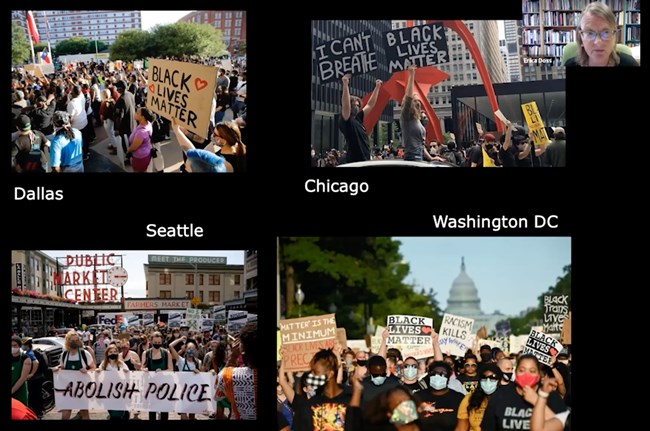
Erika Doss
Monuments Memory and Cultural Vandalism
EMMA SILVERMAN: For our third presenter, I'd like to draw Erika into the conversation now to give us some broader context for Bill and Rachel's talks about the graffiti at the Tomb of the Unknown Revolutionary War soldier and at NPS sites more generally.
Erika, can you talk about why different publics vandalize cultural property especially when that vandalism is done to make a political statement, as it was at the Tomb of the Unknown Revolutionary War soldier?
ERIKA DOSS: I can, and here we go. Let me see if I can get my PowerPoint set up here.
How does that look? OK. Thanks, Emma, for inviting me to participate in today's conversation about monuments, memory, and vandalism.
And I do sort of hope to hop on to what Bill and Rachel are talking about regarding this particular incident of vandalism. My remarks are going to focus on, as Emma suggested, how and why some American publics are motivated to deface cultural property and what these acts of cultural vandalism tell us about the meaning of monuments and memory in contemporary America.
So last summer, following George Floyd's murder in Minneapolis by police on May 25, widespread protests throughout the United States and around the world against systemic or structural racism and police violence occurred.
And I just show a few examples here of the kind of images that we saw and experienced.
Some protesters in Philadelphia, tens of thousands, rallied at the Philadelphia Art Museum or outside. Some protesters targeted public monuments, such as these managed by the National Park Service.
And Rachel showed a few of these images as well in Boston and in Washington, D.C., so the Lincoln Memorial, the World War II Memorial, and on the left the backside of the Shaw Memorial in Boston.
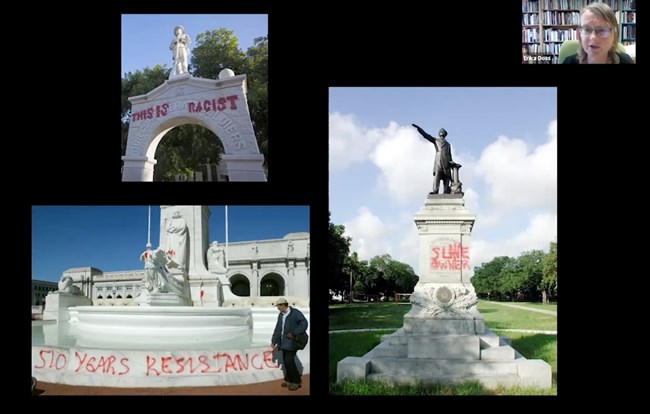
Erika Doss
Others targeted figurative sculpture in the United States, particularly of US presidents deemed representatives of white supremacy and racial inequity, such as Andrew Jackson --- this is the statue of him in Kansas City --- and George Washington. This is a statue that was toppled. So we're looking at it lying on the ground here. And yellow paint was thrown on it. And, also, you'll see on the far left of the pedestal the words "genocidal maniac."
In Philadelphia, long-time protest against this larger-than-life-sized statue of Frank Rizzo, which was in front of the city's municipal building, and those protests included --- I have on the left being yarn bombed in 2012 and dressed in a pink bikini.
Long-time protests finally led to the statue's removal by order of Mayor Jim Kenney. So this was part of the May and June protest. And likewise, this statue of Christopher Columbus in Marconi Plaza, which had similarly been the subject of sustained and really heated public protests in South Philadelphia, this was boarded up as we see on the bottom and eventually removed from the site.
And as we've seen in Washington Square here in Philadelphia, graffiti was spray-painted at the Tomb of the Unknown Revolutionary War soldier. So to the right of the Statue of George Washington --- and as Bill said, this is a copy of the statue designed by French artist Houdon --- under the sentence, "Freedom is a light for which many men have died in darkness," chiseled into this limestone wall, somebody wrote the words "committed genocide," and then underneath that as well, someone tagged ACAB short for "All Cops Are Bastards" in bright pink paint.
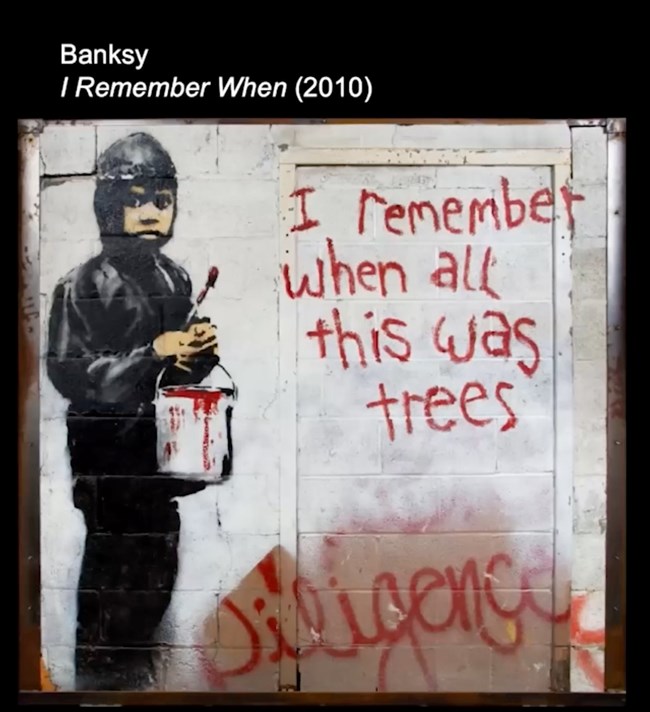
Erika Doss
Graffiti Takes Many Forms
Graffiti takes many forms.
Today, the work of the very well-known British artist Banksy is called street art, not vandalism. And it commands very high prices in the art market and generally broad appreciation for this artist's particular attention to social and political issues.
But the vandalism of national monuments disturbs people.
Hundreds of people responded to the NPS social media postings, which I include here, on these incidents in Washington and also in Philadelphia, the statement by the NPS on the left and just some of the many comments that we see on the right.
For many people, vandalism is property destruction and criminal behavior. And indeed, as Rachel pointed out, in US law, vandalism is typically considered a crime subject to penalties from fines and restitution to jail time.
The word vandalism, the art historian Sabine Marschall recounts, carries negative connotations associated with violence, unlawfulness, disrespect, disobedience, uncivilized behavior. Defacing a War Memorial that features the figure of America's founding father was seen by many as a sign of civic disorder, and it was denounced as desecration and even iconoclasm.
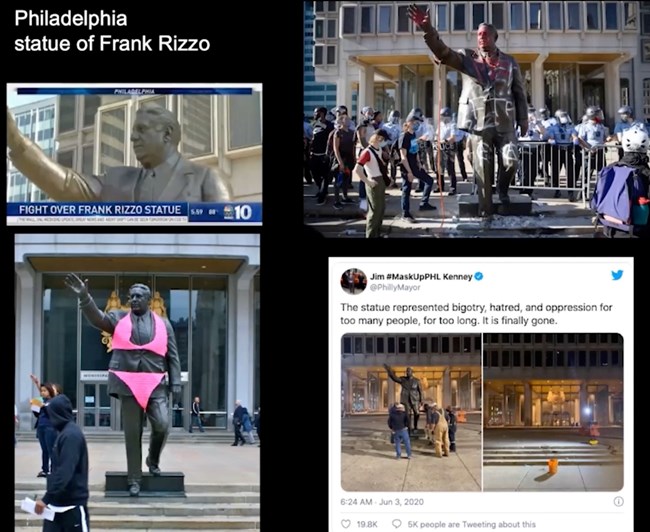
Erika Doss
Cultural Vandalism
The cultural vandalism seen here, directed at monuments dedicated to Washington, Robert E. Lee, and Christopher Columbus, is an intentional defacement of cultural property.
It is also an expression of rage, pain, and mourning, a very public declaration that things are very wrong in America, that American citizens are being brutalized, that voices are not being heard, that histories are being denied.
Defacing monuments that seem to promote systemic racism and violence or ignore, as this case suggests, George Washington's role in the destruction and devastation, his words, of Indigenous Americans to make way for a new nation of white male landowners may be seen as an act of civil disobedience, a demand for alternative, expanded understandings of early American history of how the US actually came into being.
Symbolic Capital
Monuments are the physical markers of social, political, and economic interest. They are highly visible stakeholders in historical memory. And they possess enormous degrees of power and influence, shaping how we feel about ourselves, our neighbors, our nation.
Their symbolic capital, following Pierre Bourdieu, helps shape and direct public perceptions of social order, political transition, and national identity.
When monuments embody values that Americans deem aberrant or inappropriate, when they seem to possess negative symbolic capital, such as white supremacy, slavery, Indigenous dispossession, they may be defaced. They may be removed.
I call this process cultural vandalism --- damaging and/or removing public art for reasons related to changing or shifted understandings of social and political purpose and identity.
And I want to make a distinction here between cultural heritage vandalism and cultural vandalism, which I'd be happy to elaborate on during our roundtable.
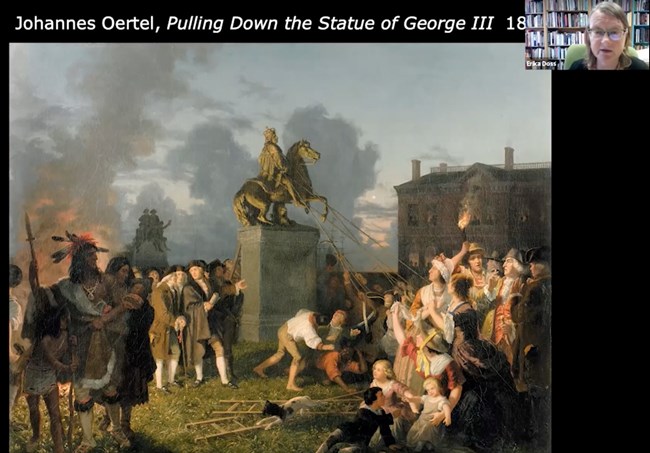
Erika Doss
Colonials: Cultural Vandals
Americans have practiced cultural vandalism since the nation's beginnings. On July 9, 1776, for example, General George Washington organized a public reading of the Declaration of Independence in New York. Thomas Jefferson listed 27 grievances against King George in the Declaration
Summarized in this sentence, "a prince whose character is thus marked by every act which may define a tyrant is unfit to be the ruler of a free people."
Inspired by words encouraging them to dissolve the political bands of tyranny, to seek unalienable rights of life, liberty, and happiness, the crowd in New York pulled down this two-ton statue of the king, which had been modeled on a statue of Marcus Aurelius.
Note the participants gather together in Johannes Oertel's version of the scene --- women, children, merchants, working men, people of color, Native Americans.
A few years later, William Walcutt also depicted the scene of America's transformation from colony to nation. His paintings similarly shows sacred power falling to the people and suggest how public rituals of cultural vandalism, here seen in the form of statue removal, helped legitimate claims to new forms of social and political authority.
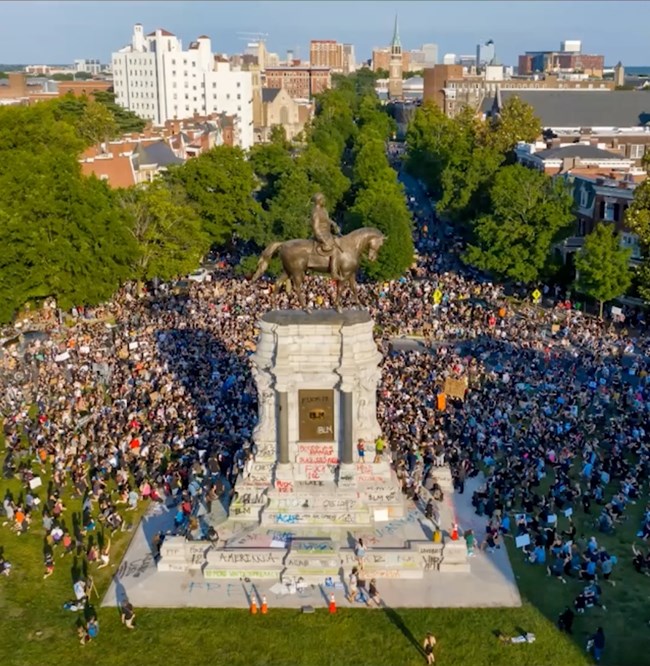
Erika Doss
Narratives of Symbolic Capital
So these practices of cultural vandalism continue today, similarly sparked by public disaffection with various forms of social and political authority, such as systemic racism and police brutality and their negative symbolic capital as embodied in some examples of public art.
The graffiti at the monument in Philadelphia may have been motivated, as Bill suggested, by discontent with laudatory or one-dimensional images of George Washington and the lack of attention to what historian Colin Calloway describes as Washington's torturous relationship with Native Americans.
Cultural vandalism makes the negative symbolic capital of troubling memorials visible. It pushes us to recognize the more nuance to the more complicated faces and facts of history. Its practice today suggests the shared concerns of Americans who aim to reconcile historical accountability with national identity and, importantly, national futurity.
In this sense, markers of dissent like the graffiti at the Tomb of the Unknown Revolutionary War Soldier challenge deficient images and deficient histories on aspirational terms as calls for change, for new ways of seeing and understanding the people, the stories that constitute American history.
Let me end by showing how those calls for change have been realized, were made manifest in Richmond, Virginia last summer when the images that we see here were projected onto that huge statue of Robert E. Lee, and the entire site became a lively, colorful space of both cultural vandalism and public interaction. Thank you.
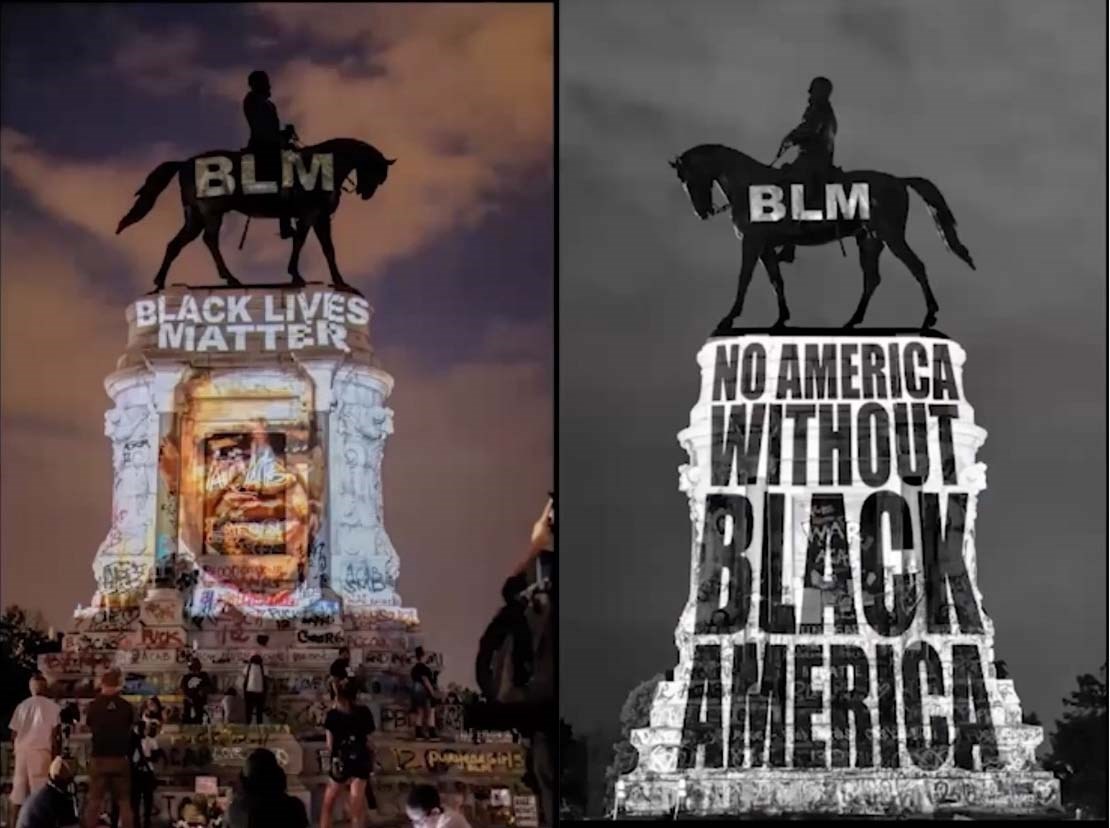
Erika Doss
